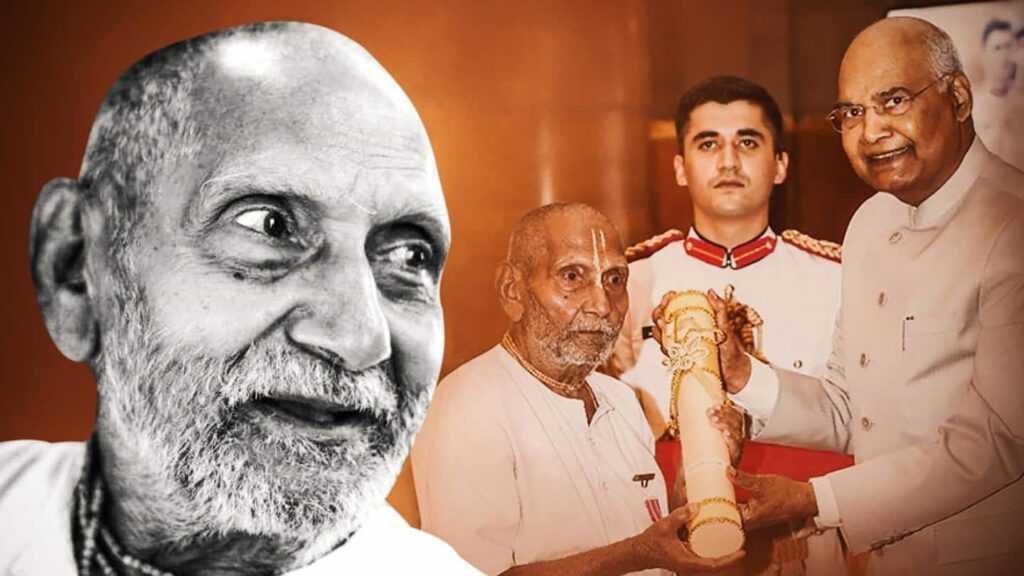On 21 Mar 2022, when the Swami Sivananda, a yoga guru, who has been practicing yoga on the Ghats of Kashi, was conferred with the Padma Shri, he sent shock waves around the country, and abroad, when he became the oldest person to receive the award, at an age of 125 years.

Born in 8 Aug 1896, in Sylhet District of Bengal Presidency, British India (now in Bangladesh), Swami Sivananda; received his training from Guru Omkarananda, mastered yoga and began serving on the ghats of Kashi.
What was surprising was not just his age, but that he was hearty and healthy at this age, absolutely disease free, with all his senses intact, without even the use of spectacles to correct his eyesight.
He has undergone numerous health check-ups, as the doctors wanted to study the structural and functional health of his vital organs. He is an active supporter of the COVID-19 vaccine and among the oldest to be administered the vaccine.
Of course, what attracts is his extremely simple life as a yogi. He wakes up at 3 am, and practises yoga. He consumes very simple- only boiled food without oil or spices, rice and boiled daal (lentil stew) with a couple of green chillies. He even avoids fruits and milk, as he considers them fancy foods. He sleeps on a mat on the floor and uses a wooden slab as a pillow.
On the other hand, we have the nation of Japan, which it is the country with the longest life expectancy and the greatest number of centenarians (people living to 100 years and beyond).
It also has the most accelerated growth of ageing in the world. In other words, life expectancy in Japanese women increased at a steady rate of near 3 months every year for the previous 160 years. Life expectancy of Japanese women in 2016 was 87.1 years.

In Japan, there is a region that is home to the population with the greatest number of centenarians worldwide: the Okinawa island, which exceed even the rest of the Japanese in life expectancy.
The diet followed by Okinawa people, has attracted the interest of many, because they not only live longer but most of them maintain active lives. In fact, Okinawa is part of the five “Blue Zones”, which comprise populations with the world’s longest-lived people and the lowest risk of age-associated diseases. Okinawa is the largest of the Japanese Ryukyu Islands, where the traditional diet is very rich in nutrients and low in calories.
Other “blue zones” are Sardinia (Italy) with the highest concentration of centenarians and the community of Seventh Day Adventists of Loma Linda in California. Nicoya Peninsula in Costa Rica is another “blue zone” where healthy centenarians live in a solid support network of friends and family.
The Okinawan diet consists of mainly plant foods with 80% of its calories coming from vegetable sources, specifically, whole grains, fruits, legumes (mainly soy), relatively small amounts of fish, and limited amounts of lean meats. The traditional Okinawan diet has 20% less calories compared to the typical Japanese diet, and a large proportion of coloured vegetables.
Sweet potatoes and rice, are the main source of carbohydrates in the Okinawan diet. The Okinawan diet has low amounts of saturated fats due to a limited consumption of eggs, meat, and dairy products. Okinawan centenarians follow the Confucian teaching of “hara hachi bu”, which is in fact a sort of caloric restriction.
“Hara hachi bu” – the Okinawan, 2500-year old Confucian mantra said before meals reminds them to stop eating when their stomachs are 80% full. This can also be a difference in feeling full and feeling satisfied. When you eat with the concept of Hara Hachi Bu, you would stop eating, at a time, when you still have capacity to eat some more food. You try to leave the table a little hungry.
Now one of the most consistent research when it comes to extended lifespan or human longevity, which has been strongly proven, is on Caloric (or dietary) restriction.
Caloric restriction refers to the reduction in the total energy intake by 20 to 40% without causing malnutrition or deficiency in essential nutrients.
Okinawans indeed appear to be one of the few populations in the world that may have experienced long-term caloric restriction without significant malnutrition, and this may be linked to their exceptionally healthy survival.
Chronic low caloric intake and chronic low protein and/or low intake of particular amino acids (e.g., methionine) may also be chronic low-intensity stressors and may have contributed to a phenomenon known as “hormesis,” where low levels of otherwise damaging agents have positive, potentially life-extending effects.

The Caloric restriction status of the older Okinawans appears to be due, in part, to a high level of occupational energy demand from their main vocation as farmers. This was coupled to low caloric intake from an energy-poor but nutrient-dense Okinawan diet.
But what’s that one common factor between Swami Sivananda, and many in the likes of him, and the centenarians from Okinawa?
It’s the concept of Hara Hachi Bu. Both eat traditional meals and foods, but eat only till they are app. 80% full or even less. Due to which they practice overall calorie restriction, a practice linked to healthy and longer human life.
In fact, in my program Genesis, this is one of the most common advices I give to all my clients. That you cannot live your life with a calculator and weight machine, to calculate the calories of every food you put in your mouth and weigh every gram of food.
The most important aspect of nutrition is to understand your own hunger patterns, and eating habits. Practicing Hara Hachi Bu could be one the best ways to do that.



